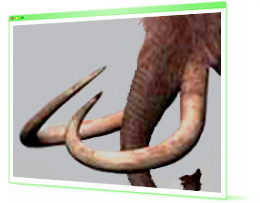My UPD8
Login to download activities, post reviews and discuss breaking science. To sign up click on join UPD8 below.
New, revised! Mammoths extinct

Type: Activity
Learning Strategy: Imaginative inquiry
Topic: Atmosphere & climate change
This activity is a sample from version 2 of the Extinction unit, part of the upd8 wikid course. Find out more about the course
Introduction to the Extinction unit
As the Arctic ice melts away, polar bears are sliding towards extinction. Climate change is radically altering many of the Earth's environments. Will other species be able to adapt? Earth's history also shows there have been many extinctions in the past. So should we be worried that species are dying out today? And which should we be trying to save? Students are trainee reporters for environmental awareness channel Planet TV. As part of their assignments they learn about the changing atmosphere, adaptation, variation and classification, behaviour, collaboration, developing argument and scientific communication.
Download the Extinction unit guide to see the How Science Works and content coverage
About this activity
The students are on their first assignment as trainee reporters for Planet TV. They have been sent to Siberia where they helped Lauren, an experienced reporter, produce an 'on the spot' news report on the discovery of a frozen baby mammoth. They learned what Europe was like 15,000 years ago when mammoths were alive and suggested what might have changed to make Mammoths become extinct.
Now their editor thinks there's a bigger story so they are sent to Yakutsk to cover a Mammoth conference. They collect evidence from an international panel of experts to find out what changed when the mammoths became extinct. The experience shows scientists from different disciplines collaborating to gather evidence and come up with explanations.
Download the PowerPoint presentation to see the sample activity
11-14 How Science Works:
The unit focusses on 'Scientific Communication': (PoS 2.3, strategy 1.1a2)
Good communication captures attention, keeps the audience interested, and gets the message across with clarity and impact.
Published: 3rd June 2008
Reviews & Comments: 1
Learning objectives
- The composition of the atmosphere has changed continuously since Earth formed and so has the climate.
Try the activity
- Mammoths detailed lesson plan
Downloaded: 164 times - Extinction unit guide
Downloaded: 139 times - Mammoths PPT Lesson Presentation
Downloaded: 207 times
You will need Acrobat Reader installed to open the activity sheets.
Curriculum link
Changing atmosphere (PoS 3.4c, strategy 5.3)Running the activity
Download the lesson plan for full details.
Reviews & Comments
Write your online review to share your feedback and classroom tips with other teachers. How well does it work, how engaging is it, how did you use it, and how could it be improved?
New, revised! Mammoths extinct review
Dec 9th, 2008

Good resource to use as part of the evolution topic in year 10
Reviewer: Sarah Brookes

Related Activities
Earth Science / Atmosphere & climate change
- Climate Futures Introductory Task
- Green Biker
- Food for Thought
- Smart Energy
- Global Warming Swindle
- Glacial meltdown
- Secrets from the ice
- Sea tubes to solve climate crisis?
- The Day After Tomorrow: The Prequel
- The Day After Tomorrow
- Our atmosphere: the hottest investment on the Planet!
- Climate control
- Global warming-do 'the facts' stand up?
- Watching the ice
- Climate Change - what will YOU do?
Biology / Feeding relationships
- Vultures: the next dodos?
- Monster crab invasion
- Mite Attack
- Rats
- Art Attack
- Goya: huge, hunted, and extinct
- Chernobyl 20 years on
Hot Topics / Disaster
- Global Warming Swindle
- Cyclone
- Glacial meltdown
- Carbon Control
- The Day After Tomorrow: The Prequel
- Tsunami Warning
- Climate Change - what will YOU do?
- Our atmosphere: the hottest investment on the Planet!
- The Day After Tomorrow
- Global warming-do 'the facts' stand up?
- Climate control
- So windy
- Arctic seed bank
QCA / 7C Environment & feeding relationships
Ideas about Science / Interpreting evidence
- Pomegranate ovary model
- Boys, girls, and chimps
- The short side of the family
- Secrets from the ice
- Pluto: a planet no more
- Fast car
- Gold
- Shampoo claims - truth or lies?
- Goya: huge, hunted, and extinct
- Shrinking Everest?
- Rats
- Acid rain: Britain recovers?
- MMR
Ideas about Science / Data collection & analysis
- Choosing trainers
- Turkey
- Inside Easter Eggs
- Santa 2025
- Bionic body
- Carbon Control
- When will women overtake men?
- Bushtucker challenge
- Tour de Science
- Riches from the Wind
- High Speed Risk
- Should we be worried about salt?
- False diamonds
- Healthy Eating
- Think 30 for a reason
- Winter Olympics
- Einstein's time